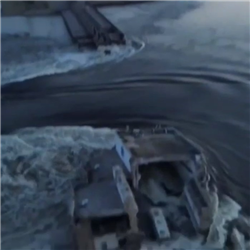Russian Terrorist Act at the Kahovka Hydroelectric Power Station: Consequences For People, Environment And Ecology

Learn more about the aftermath of the Russian terrorist attack on the Kakhovskaya HPS and its impact on Ukraine and the Black Sea region. The destruction of the station caused a danger to the population and a threat to the environment.
On June 6, 2023, at around 2:30 a.m., the Kahovka hydroelectric power station (HPS) located in Ukraine was sabotaged by Russian aggressors. This act of terrorism created an extremely dangerous situation for Ukrainian citizens residing in settlements on both banks of the Dnieper River downstream of the Kahovka reservoir. It was undoubtedly an act of ecological destruction and an obvious crime against peace, which has an impact not only on Ukraine but also on the entire ecosystem of the Black Sea region. The Kahovka HPS provided electricity, irrigation, and water supply to the arid southern regions of Ukraine. As known, the Kahovka HPS has been completely destroyed and is not subject to restoration. Let's examine in more detail the consequences of the sabotage at the Kahovka HPS and its potential impact on the ecosystem and people.
1. Water Pollution
After the sabotage, significant amounts of harmful substances and toxic materials enter the water bodies, including rivers and lakes. This can lead to water pollution, disruption of the balance in aquatic ecosystems, and a threat to water organisms such as fish and water birds. Water pollution can also negatively impact the health of local residents who rely on these water resources for drinking and other needs.
2. Destruction of Natural Environment
The sabotage at the Kahovka HPS can cause significant damage to the natural environment. Large masses of soil, plants, and trees can be destroyed or flooded, which has a negative impact on the region's biodiversity. The destruction of natural habitats can lead to the extinction of various plant and animal species that are integral parts of the ecosystem.
3. Disruption of Ecological Processes
Sabotage at a hydroelectric power plant can disrupt natural ecological processes that play a crucial role in maintaining the balance of the ecosystem. Changes in water levels in rivers or lakes can result in the flooding of coastal areas. This can lead to the loss of habitats for water birds and animals that rely on these ecosystems for their survival and reproduction.
4. Disruption of Fisheries
The Kahovka HPS had a significant impact on fisheries and the provision of fish resources in the region. The sabotage can lead to the death of a large number of fish due to changes in the aquatic environment and water pollution. This can have serious consequences for commercial and subsistence fishing, as well as for the conservation of fish species that are under the threat of extinction.
5. Impact on Local Population
The sabotage at the Kahovka HPS can also have a major impact on the local population. Loss of residential areas, deterioration of water quality, and environmental pollution can negatively affect the health of local residents. In addition, economic losses due to the destruction of fisheries and agriculture in spill sites can affect the lives of local communities.
Russian Terrorist Act at the Kahovka HPS has serious consequences for the environment, ecology, and local population. It is important to pay proper attention to the restoration of the ecosystem and the reduction of the negative impact on the environment. The following steps can be taken to mitigate the disaster's consequences:
1. Remediation and purification of water bodies:
Immediate action is needed to initiate the process of purifying water from toxic substances and pollutants. The use of effective filtration and purification systems will help reduce pollution levels and restore water quality.
2. Restoration of vegetation and natural environment:
Restoration work needs to be carried out to restore vegetation and the natural environment that were destroyed during the sabotage. Planting new vegetation, restoring ecosystems, and preserving natural habitats will contribute to biodiversity restoration and improved ecological resilience.
3. Monitoring environmental indicators:
It is important to establish a monitoring system to track the state of the environment, water quality, pollution levels, and their impact on fish stocks and other organisms. This will help identify issues in a timely manner and take appropriate actions to prevent further damage.
4. Protection of vulnerable species:
Measures need to be taken to protect and preserve vulnerable species that may be affected as a result of the explosion. Establishing protected areas and implementing breeding and population restoration efforts will help maintain the balance in the ecosystem.
5. Involvement of the public and environmental organizations:
Collaboration with local community organizations and environmental groups is a crucial aspect of ecosystem restoration following the explosion. This includes spreading information about the consequences of the explosion, mobilizing volunteers for cleanup efforts, and engaging experts and scientists in research and the development of restoration strategies.
6. Implementation of strict environmental standards:
It is necessary to enforce strict environmental standards and regulations to prevent similar incidents in the future. Regular inspections, mandatory audits, and an effective monitoring system will help ensure the safety and environmental sustainability of hydroelectric power plants.
7. Further research and innovation:
It is important to support research and innovation in the field of ecology and natural resource restoration. The development of new technologies for water purification, restoration of vegetation cover, and replenishment of fish stocks can contribute to the rapid recovery of the ecosystem after the explosion.

